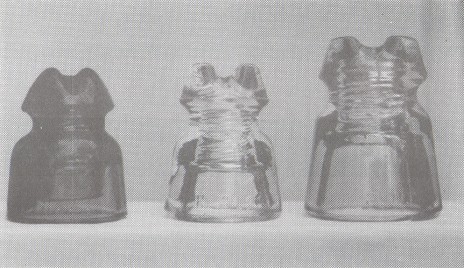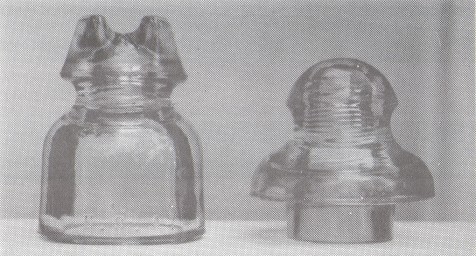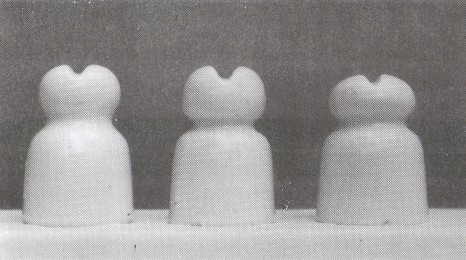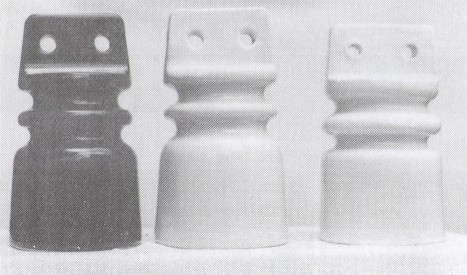Foreign Insulators
by Marilyn Albers
Reprinted from "Crown Jewels of the Wire", August 1992, page 23
MAJORCA REVISITED
When Carol McDougald and I were in Majorca in May of 1990, we did little else
but look for the rare and elusive CD 680, a small unmarked T-bar in straw or red
amber glass that we believe can be found only on this Spanish island. We were successful
in finding 4 of the ambers and 6 in straw, all of which quickly went into
collections. But even at that time we were told that these are very old, they
are not being used any longer and the chances of finding any were pretty slim.
Those that we did get were retrieved from the dumpsters at the main electric
company called GESA, for Gas y Electicidad S.A.
Majorca is such a beautiful
place and it seemed almost sinful not to see more of it than we had allowed time
for, so this past Spring, my husband Bill and I spent from May 13-29 enjoying
all the wonderful scenery, beaches, mountains, castles, historic old buildings,
forts, castles, leather and glass factories, caves, the blue Mediterranean,
windmills, Palma Cathedral (construction begun in the 1200 's), the monastery in
Valldemosa where Chopin composed some of his famous sonatas while spending the
winter there with his companion, George Sand. Then there was Petra, the
birthplace of Friar Juniper Serra, who was responsible for establishing several
missions in California, which eventually became cities -- San Francisco, San Luis
Obispo, Santa Barbara, etc. We had a good time! But we also wanted to see if we
could find any more of the little glass T-bars. Carol and I had seen a few in
1990, high up on the fronts of buildings where they were still cemented to the
walls, but without wires. Our main problem then had been that there was no way
for us to get them down.
As Bill and I began to walk the streets of the small
towns, we found all new installations and no more T-bars! We covered a lot of
ground, thinking surely there must be a few left, but these were just not
anywhere in sight. There seems to have been a real clean up effort on the
island, which, as I look back, had already begun when Carol and I were there
before. Perhaps in anticipation of the many tourists who would be coming over
either before or after the Summer Olympics in Barcelona during July and August?
We did spot a couple, but when we went to stand below them, we could see that
they were completely split in two or were broken and left to dangle by the arms from a disconnected wire. Finally, a couple of days
before we were to leave the island, we saw one on a narrow street and were so
excited we refused to leave the spot until we found someone to take it down for
us. Eventually, with the help of a lady at a nearby bank who spoke a little
English, and a man with an extension ladder who was willing to take it down for
us (for a price), we were able to get one red amber CD 680. It had appeared mint
from the ground, but when it was put into Bill's hands, he saw that it had quite
a bit of damage. But even that didn't bother us, because it had been a thrilling
experience just the same and this little insulator was pretty special. It is now
a very treasured souvenir of our trip and safely displayed in a lighted cabinet
behind glass. In addition, we did, by some miracle, find one vvnm specimen in
straw at GESA' S dump, which, by prior arrangement, went into a collection here
in the States. These CD 680's are truly very rare!

CD 680 T -Bars from Majorca in straw and in red amber
But woe were able to bring back several other styles of glass and porcelain
insulators. In fact, we had 200 lbs. of baggage when we were weighed in at the
airport in Palma, headed for home. Why we weren't charged overweight, we'll
never know. The photos show the different varieties that we found during our
stay in Majorca. All of the glass insulators used on the island are made by
ESPERANZA S.A. (E. S .A. ), a company that is located in the city of Marquina,
Vizcaya, near the northern border of Spain, and it certainly appears that there
is no competition from any other glass manufacturer. We were told the taller
porcelains (spooks) were made in Barcelona, but since they are not marked, they
cannot be attributed to any certain manufacturer.
|

|
|
CD 574.2 E.S.A. / 21 |
CD 516.5 E.S.A. / 21
|
CD 523 E.S.A. / A. V.I |
|

|
| CD 525 E.S.A.
/ 24 |
CD 470 E.S.A. / N.95 |

U-1649 N N
(product of PORCELANAS GIRALT, Madrid) (variations)
|

|
|
New U# N N in brown or white |
New U# N N in white only, a variation of the two at the
left |
.
|
